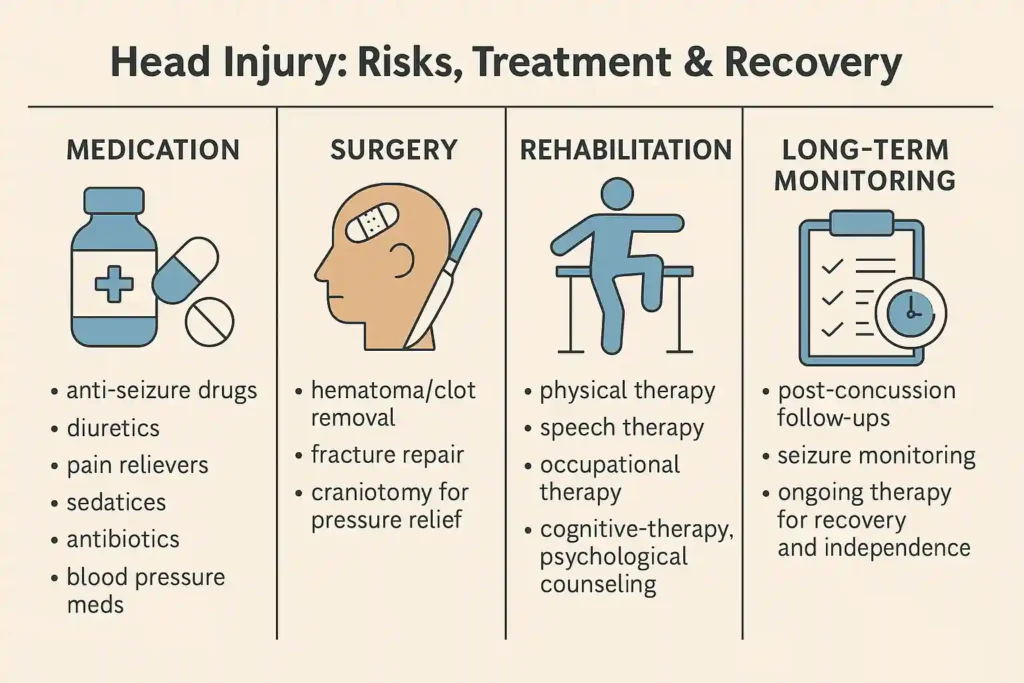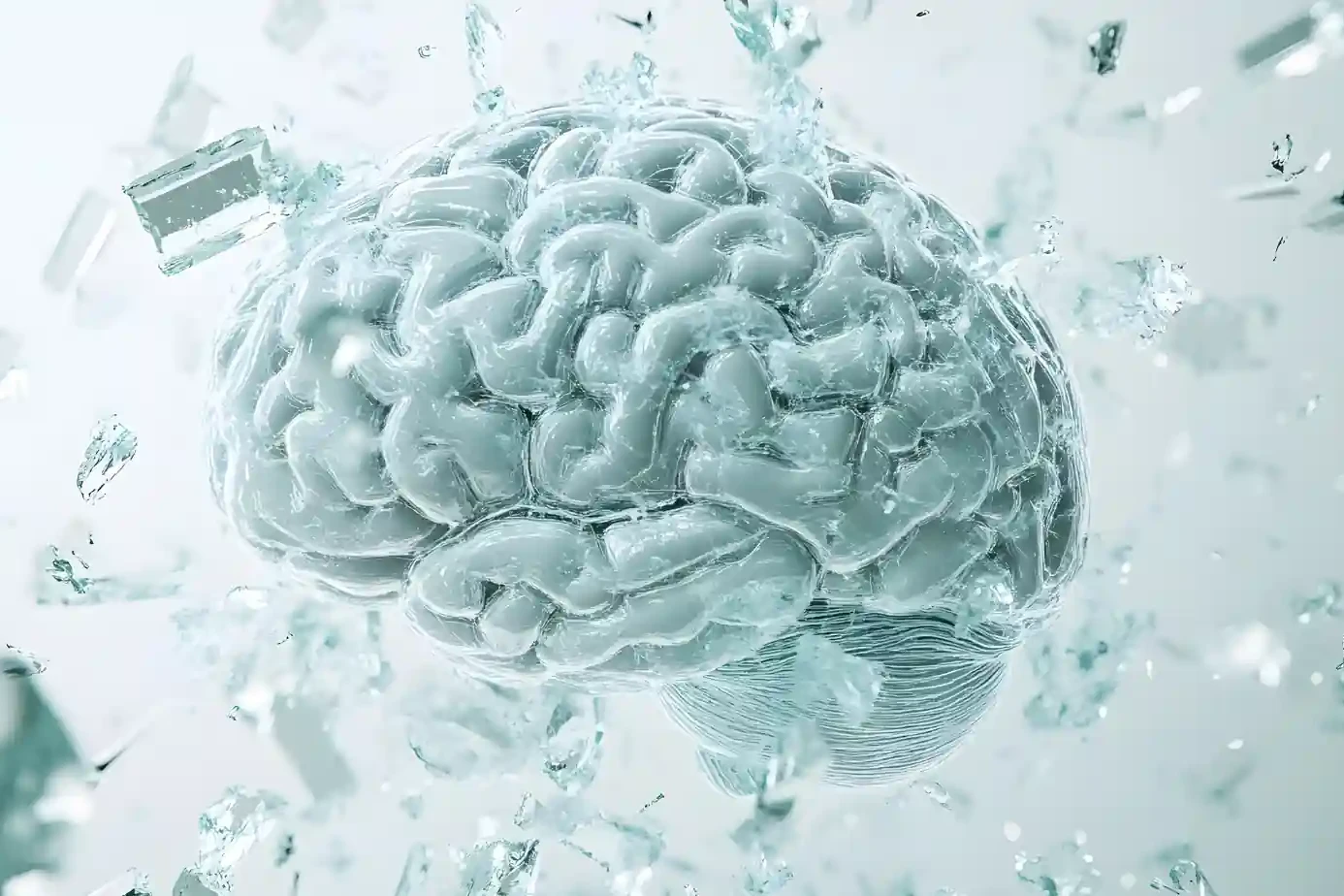A head injury is more than merely a bump or bruise. It can affect the brain, skull, and scalp, sometimes leading to life-threatening complications. Because the brain controls every function of the body, even a mild injury needs attention.
Whether it’s a fall, a sports accident, or a road crash, understanding the risks of head injuries helps in recognizing early signs and preventing permanent damage.
This guide explains causes, types, symptoms, diagnosis, treatment, and recovery of head trauma in simple words.
Table of Contents
ToggleWhat Can Cause a Head Injury?
A head injury happens when the brain, skull, or scalp suffers damage from an external force.
The most common causes include:
- Falls: Older adults often suffer injuries from bathroom slips, while children may fall during play.
- Road accidents: Bicycle, car, or pedestrian accidents continue to be a major cause of traumatic brain injury.
- Sports: Contact sports such as football, boxing, cycling, and skating pose a significant risk for concussion symptoms and post-concussion syndrome.
- Violence: Physical assaults or blunt force trauma can result in serious head injuries.
- Workplace injuries: Construction sites, factories, and high-risk jobs expose workers to falling objects and accidents.
Even if it seems like a closed head injury, hidden damage such as intracranial bleeding or brain swelling after trauma can be fatal.
What Are the Major Types of Head Injuries?

Doctors classify head injuries into several types depending on the structure affected and the severity of damage.
Hematoma
A hematoma refers to a blood clot that develops when blood escapes from a vessel. Inside the skull, this trapped blood creates pressure that squeezes the brain.
- Causes: Car accidents, falls, sports collisions, or blows to the head.
- Symptoms: Headache, vomiting, weakness in limbs, or confusion.
- Why it’s dangerous: The skull is rigid, so even a small hematoma can dangerously compress the brain and lead to traumatic brain damage. Emergency surgery is often needed.
Hemorrhage
A hemorrhage means bleeding, either inside the brain or around it.
- Types:
- Intracerebral hemorrhage: bleeding directly in brain tissue.
- Subarachnoid hemorrhage: bleeding in the space between brain and protective layers.
- Symptoms: Sudden headache, sensitivity to light, neck stiffness, or loss of consciousness.
- Risk: Even small bleeds can cause swelling and intracranial bleeding, which interrupts blood flow and oxygen supply. Quick imaging tests (CT or MRI) are used to confirm it.
Concussion
A concussion is the most common closed head injury, often seen in sports and falls. It happens when the brain shakes against the skull.
- Symptoms: Headache, dizziness, memory issues, blurred vision, or nausea; common concussion symptoms.
- Recovery: Most heal with rest, but repeated concussions increase the chance of post-concussion syndrome, where problems like headaches and poor focus last for weeks.
- Risk: Even a mild concussion should never be ignored because it can mask deeper injury.
Edema
Edema means swelling. After head trauma, tissues in the brain may swell with fluid.
- Symptoms: Intense headache, nausea, confusion, or sudden visual disturbances.
- Risk: Brain swelling after trauma increases pressure inside the skull, restricting blood flow. Doctors may perform surgery or use medicine to reduce swelling and keep oxygen supply stable.
- Monitoring: Hospitals use special tools for monitoring intracranial pressure in severe cases.
Skull Fracture
A skull fracture signifies a break in the bone that safeguards the brain. Unlike other bones, the skull is thin and fragile in some areas.
- Types:
- Linear fracture: a simple crack.
- Depressed fracture: bone pressed inward.
- Basilar fracture: a fracture located at the base of the skull, frequently accompanied by clear fluid leakage from the nose or ears.
- Risk: Broken skull bones can cut brain tissue or blood vessels, leading to infection or bleeding. Some fractures need surgery, while simple ones heal on their own.
Diffuse Axonal Injury
This is one of the most serious types of severe head trauma. It occurs when strong shaking or rotation tears nerve fibers throughout the brain.
- Causes: High-speed crashes, falls from height, or shaken baby syndrome.
- Symptoms: Loss of movement, coma, or unresponsiveness.
- Risk: Because nerve connections break, patients may face permanent disability or even death. Recovery is often long and requires intensive rehab.
What Are the Symptoms of a Head Injury?

Spotting early symptoms of head injury is vital because even small issues can quickly worsen.
Symptoms of a Minor Head Injury
- Mild headache
- Small cut or bump
- Dizziness and nausea after head injury
- Brief confusion
- Blurred vision
- Fatigue
Symptoms of a Severe Head Injury
- Persistent headache that worsens
- Vomiting repeatedly
- Slurred speech
- Clear fluid from nose or ears
- Seizures
- Trouble waking up
- Cognitive impairment after head trauma such as poor memory
- Weakness or numbness in arms or legs
- Passing out
These symptoms of head trauma should never be ignored.
When Does a Head Injury Require Medical Attention?
Any head trauma with worsening symptoms needs urgent care.
Seek emergency care for head trauma if you notice:
- Seizures or repeated vomiting
- Long or repeated loss of consciousness
- Severe confusion or agitation
- Inability to stay awake
- Clear discharge of blood or fluid
- Weakness or loss of balance
Even a mild-looking closed head injury can hide serious intracranial bleeding.
How Is a Head Injury Diagnosed?
Doctors begin with a head injury assessment.
This includes:
- Checking vital signs like breathing and pulse
- Neurological assessment to test reflexes, balance, memory, and speech
- Checking pupils with light
Tests include:
- CT scan to detect bleeding, swelling, or fractures
- MRI to reveal nerve fiber injuries and subtle traumatic brain damage
- Glasgow Coma Scale (GCS), a brief test of head injury, measures eye opening, verbal, and motor response
How Is a Head Injury Treated?
The treatment for a head injury is contingent upon the severity of the damage, whether it is a mild concussion or a case of severe head trauma. Doctors focus on stopping further harm, reducing complications, and helping the patient recover brain function.
Medication
Medicines play a big role in both emergency care and long-term management.
- Anti-seizure drugs: Head injuries can trigger seizures. Doctors prescribe medicines to control this risk.
- Diuretics: These drugs help reduce fluid build-up and lower brain swelling after trauma, preventing dangerous increases in pressure inside the skull.
- Pain relievers: Mild cases may need over-the-counter painkillers, but stronger injuries require prescribed medications. Aspirin is usually avoided as it can worsen intracranial bleeding.
- Sedatives: Sometimes used to calm restless or agitated patients. This prevents sudden movements that can increase brain pressure.
- Antibiotics: If there is an open skull fracture, antibiotics help protect against infection.
- Blood pressure medicines: Keeping blood flow stable is vital to maintain oxygen supply to the brain.
These treatments are often the first step before deciding if surgery is needed.
Surgery
Some cases of traumatic brain injury need immediate surgical care. Doctors operate to relieve pressure, repair damage, or remove dangerous blood clots.
- Removing hematomas or clots: Blood trapped inside the skull presses on the brain. Surgery clears it to prevent further damage.
- Repairing fractures: Complex skull fractures may require plates or screws to stabilize the bone and protect the brain.
- Stopping bleeding: Emergency surgery may be done to stop uncontrolled intracranial bleeding.
- Pressure relief surgery: Surgeons sometimes perform a craniotomy, where part of the skull is temporarily removed to allow a swollen brain to expand safely. This lowers the risk of death from extreme pressure.
Surgery is often life-saving, especially when patients show signs of severe head trauma like unconsciousness, seizures, or worsening swelling.
Rehabilitation
After the emergency phase, recovery continues through rehabilitation. The brain may take weeks or months to heal, and some patients face lasting challenges. Rehab aims to restore independence and daily functioning.
- Physical therapy: Helps regain movement, strength, and balance after injury.
- Speech therapy: Supports patients who struggle with speech, communication, or swallowing after a traumatic brain injury.
- Occupational therapy: Teaches skills for daily life, such as dressing, cooking, or managing tasks at work.
- Cognitive therapy: Focuses on memory, problem-solving, and attention issues linked to cognitive impairment after head trauma.
- Psychological counseling: Emotional changes like depression, anxiety, or irritability are common. Counseling supports mental health during recovery.
- Long-term monitoring: Some patients need follow-ups for post-concussion syndrome, seizures, or ongoing therapy.
Rehab can last months to years depending on the severity. The goal is to help patients regain independence, prevent complications, and improve quality of life.
The Bottom Line
A head injury may appear minor but can quickly become life-threatening. Recognizing symptoms of head trauma, getting a head injury assessment, and seeking emergency care for head trauma saves lives.
From mild concussions to severe head trauma, every injury deserves attention. The safest choice is to get checked when unsure.
FAQs
How to know if a head injury is serious?
A serious injury causes seizures, vomiting, unconsciousness, confusion, or clear fluid from ears or nose. Immediate head injury assessment is required to rule out hidden bleeding or swelling.
What to do when you hit your head?
Apply ice, rest, and monitor for worsening symptoms of head trauma. If nausea, confusion, or prolonged headache occurs, seek emergency care for head trauma right away.
What is the definition of a head injury?
A head injury is any damage to the scalp, skull, or brain caused by external trauma. It includes cuts, bruises, fractures, and traumatic brain injury conditions.
What are five danger signs of a head injury?
Danger signs include seizures, vomiting, fluid discharge, confusion, and loss of consciousness. These indicate possible intracranial bleeding or brain swelling after trauma and require urgent care.
What is the brief test of head injury?
The Glasgow Coma Scale checks brain function. It measures speech, movement, and eye opening. Doctors use it to detect traumatic brain damage and assess severity quickly.
What are alarming symptoms after a head injury?
Alarming symptoms include severe headache, slurred speech, confusion, seizures, or weakness in limbs. These symptoms of head trauma demand immediate neurological assessment and medical care.
What are five danger signs of a head injury?
Seizures, vomiting, confusion, weakness, and fluid from nose or ears are five critical warning signs. These may suggest intracranial bleeding or serious traumatic brain injury.
How to confirm brain injury?
Doctors confirm brain injury through CT or MRI scans along with a neurological assessment. These tests reveal traumatic brain damage, fractures, and monitoring intracranial pressure if swelling is suspected.
About The Author

This article is medically reviewed by Dr. Chandril Chugh, Board-Certified Neurologist, providing expert insights and reliable health information.
Dr. Chandril Chugh is a U.S.-trained neurologist with over a decade of experience. Known for his compassionate care, he specializes in treating neurological conditions such as migraines, epilepsy, and Parkinson’s disease. Dr. Chugh is highly regarded for his patient-centered approach and dedication to providing personalized care.
→ Book a consultation to discover which remedies suit your needs best.




